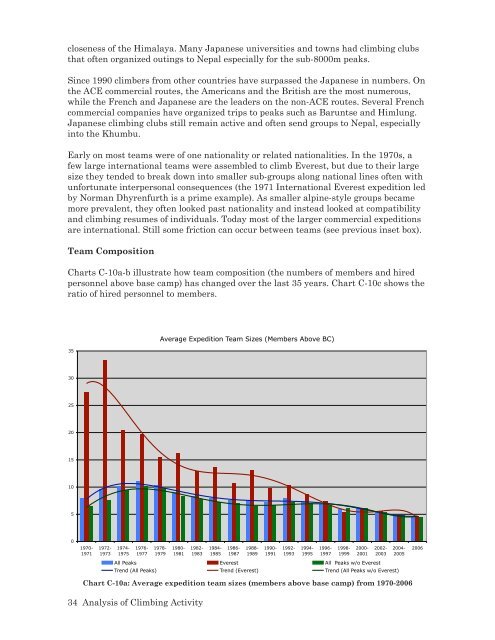The Himalaya by the Numbers: A Statistical Analysis - Himalayan ...
The Himalaya by the Numbers: A Statistical Analysis - Himalayan ...
The Himalaya by the Numbers: A Statistical Analysis - Himalayan ...
You also want an ePaper? Increase the reach of your titles
YUMPU automatically turns print PDFs into web optimized ePapers that Google loves.
closeness of <strong>the</strong> <strong>Himalaya</strong>. Many Japanese universities and towns had climbing clubs<br />
that often organized outings to Nepal especially for <strong>the</strong> sub-8000m peaks.<br />
Since 1990 climbers from o<strong>the</strong>r countries have surpassed <strong>the</strong> Japanese in num bers. On<br />
<strong>the</strong> ACE commercial routes, <strong>the</strong> Americans and <strong>the</strong> British are <strong>the</strong> most numerous,<br />
while <strong>the</strong> French and Japanese are <strong>the</strong> leaders on <strong>the</strong> non-ACE routes. Several French<br />
commercial companies have organized trips to peaks such as Baruntse and Himlung.<br />
Japanese climbing clubs still remain active and often send groups to Nepal, especially<br />
into <strong>the</strong> Khumbu.<br />
Early on most teams were of one nationality or related nationalities. In <strong>the</strong> 1970s, a<br />
few large international teams were assembled to climb Everest, but due to <strong>the</strong>ir large<br />
size <strong>the</strong>y tended to break down into smaller sub-groups along national lines often with<br />
unfortunate interpersonal consequences (<strong>the</strong> 1971 International Everest expedition led<br />
<strong>by</strong> Norman Dhyrenfurth is a prime example). As smaller alpine-style groups became<br />
more prevalent, <strong>the</strong>y often looked past nationality and instead looked at compatibility<br />
and climbing resumes of individuals. Today most of <strong>the</strong> larger commercial expeditions<br />
are international. Still some friction can occur between teams (see previous inset box).<br />
Team Composition<br />
Charts C-10a-b illustrate how team composition (<strong>the</strong> numbers of members and hired<br />
personnel above base camp) has changed over <strong>the</strong> last 35 years. Chart C-10c shows <strong>the</strong><br />
ratio of hired personnel to members.<br />
35<br />
30<br />
25<br />
20<br />
15<br />
10<br />
5<br />
0<br />
1970-<br />
1971<br />
1972-<br />
1973<br />
1974-<br />
1975<br />
1976-<br />
1977<br />
Chart C-10a: Average expedition team sizes (members above base camp) from 1970-2006<br />
34 <strong>Analysis</strong> of Climbing Activity<br />
Average Expedition Team Sizes (Members Above BC)<br />
1978-<br />
1979<br />
1980-<br />
1981<br />
1982-<br />
1983<br />
1984-<br />
1985<br />
1986-<br />
1987<br />
1988-<br />
1989<br />
1990-<br />
1991<br />
1992-<br />
1993<br />
1994-<br />
1995<br />
1996-<br />
1997<br />
1998-<br />
1999<br />
2000-<br />
2001<br />
All Peaks Everest All Peaks w/o Everest<br />
Trend (All Peaks) Trend (Everest) Trend (All Peaks w/o Everest)<br />
2002-<br />
2003<br />
2004-<br />
2005<br />
2006


